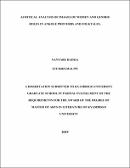| dc.description.abstract | The study critically analyses the image of women and gender roles in Ankole proverbs and folktales. The study was guided by three objectives: the stylistic aspects of the paralinguistic features in performance of Ankole folktales and proverbs; the image of women in Ankole proverbs, and the portrayal of gender roles in Ankole proverbs and folktales. The study was both field and library-based, employing a qualitative approach. The study used sociological and performance theories to analyze data. The major tenet of the sociological theory is that literature is a reflective-mirror of society and social realities. As such, the images of women and gender roles depicted in the proverbs and folktales are a true reflection of people’s perceptions of women in Ankole society. The study notes that performance is a very important ingredient in the appreciation, preservation and transmission of folktales and proverbs. Folktales are seen as a source of entertainment and a medium of instruction that enhances the young children’s learning of the cultural values, customs and norms of their society. Folktales have special opening and closing formulae, and the closing style of Ankole folktales depends on the group of the Banyankole, and the ending of each group reflects its economic activities. The study findings reveal that women are portrayed as children, dim-wits, murderers, evil, unreliable, untrustworthy, and greedy. They are presented as trouble-rousers not only to themselves, but the entire community. They are capable of causing discord and division among the community members; they seem not to distinguish between good and bad. The study also shows that cultural roles in Ankole community are distributed according to gender. There is a clear distinction between roles performed by men and those performed by women in Ankole society. There is no swapping of roles, everyone does the assigned role and cannot be swapped even in time of emergence. And finally, the study recommends that curriculum designers of primary and secondary schools put emphasis on the integration of oral literature in the literature teaching syllabus to help preserve oral literature genres. | en_US |

